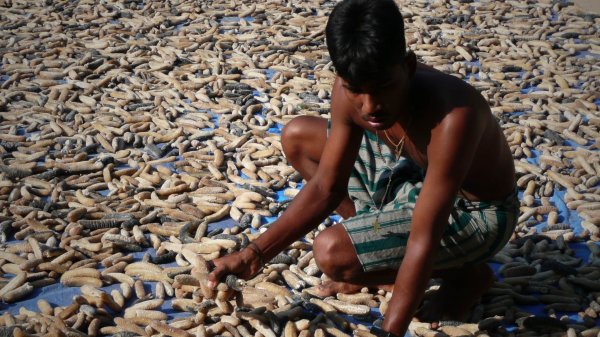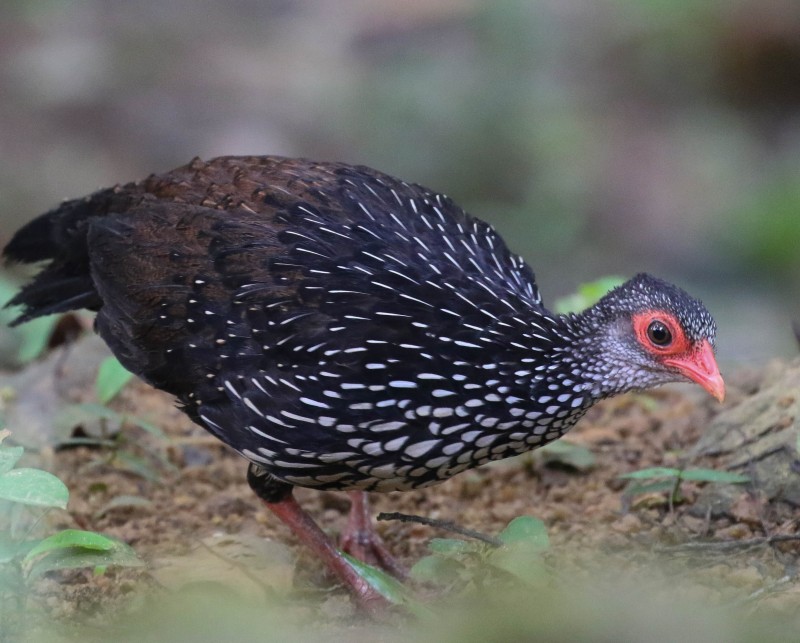
Picture this: a leopard in the wild. It doesn’t matter if it is bringing down a150 pound buck, having a game of rough-and-tumble with a litter-mate, or simply snoozing on a shady branch. Out there, it is wild, unfettered, and free in every sense of the word.
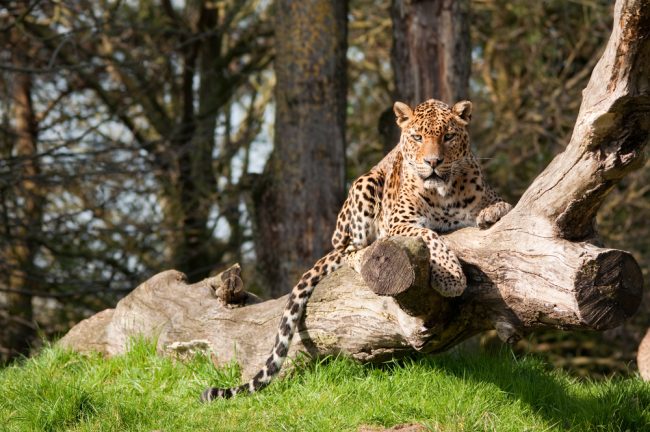
Born free; a leopard in the wild/ Image credits: invitetoparadise.com
Did you know that leopards can reach running speeds of up to 58 km an hour? Or that they can climb trees easily, even while carrying heavy prey? Now, take the leopard out of its natural habitat and stick it in a cage, and all these marvelous features dwindle down into meaninglessness. It doesn’t matter if it has the ability to run at 58 km an hour, 20 km an hour, or if it just crawls along at snail’s pace ‒ there is no room to run in a cage. It doesn’t make a difference if it is the master of tree-climbing or not; there are no trees to climb behind bars.
The suffering of animals in captivity can be blamed chiefly on ignorance, profit, entertainment, and lack of proper legislation concerning animal cruelty. Today, there are countless creatures silently suffering abuse and captivity at the hands of people. The problem areas are vast, affecting everything from floppy-eared rabbits languishing in poky pet shops, to the majestic elephant, forced to walk in chains for miles in the searing heat in some parade or the other. Even the Dehiwala Zoo is now a sad, shabby place that is steadily getting worse, the animals being incarcerated in the most appalling conditions. In spite of growing concerns for the welfare of our furred and feathered friends, the situation seems to be escalating rather than declining, prompting animal rights activists and animal lovers all over Sri Lanka to push hard for a change. What is truly distressing is the fact that despite being a culture that takes pride in its compassion and kindness towards all living creatures, cruelty towards animals seems to thrive in many forms. A testament to this was the recent horrific episode involving a group of men who inhumanely killed an eagle by skinning it alive and cutting off its claws ‒ an incident so sickening, cruel, and pointless that it left people reeling with shock.
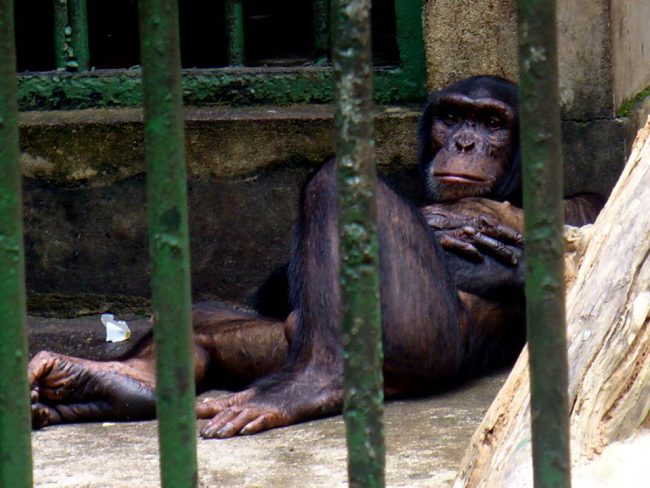
Tony the chimp, who starred in the ‘Chimp Show’ at the Dehiwala zoo. As Tony grew older, he grew more and more aggressive, finally biting off the finger of his keeper in 2014/ Image credits: window2nature.wordpress.com
Animal Shows And Parades
How many times have you sat down to watch the Elephant Show at the Dehiwala Zoo? Or paid Rs. 150 to a gypsy to see his dressed up little monkey perform a few quaint tricks? We are often guilty of enjoying these displays without ever really realising that our few minutes of entertainment come at the cost of years of captivity and subjection to cruelty and negligence.
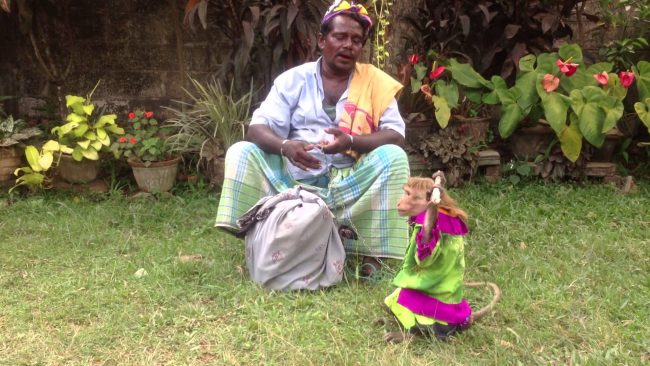
Cute, quaint and often cruel; a performing monkey doing his tricks/ Image credits: youtube.com
Take another look at the Elephant Show ‒ after the initial delight wears off, there is something horribly wrong with the sight of these regal animals, so unassailable in the wild, reduced to balancing on lurid wooden stools and performing tricks for crowds, all the while cringing from the jabs of the mahout’s henduwa.
Recently, a new problem has come to light; it seems to have become the trend for even schools to use elephants in their school parades. This is the latest blow to animal rights activists and animal lovers who are already rallying against exploiting these creatures in all kinds of parades, pageants and shows. Not only does this practice pose a serious public safety risk, but the elephant is also forced to walk long distances on the burning asphalt, amid all the revelry and noise of the celebration, with the mahout giving it regular pokes and prods to keep it under control. And just in case you were under the impression that the elephant is swaying because it is enjoying the papare, it is not ‒ elephants are known to sway and rock when they are distressed.
Elephants are also used as tourist attractions in many hotels all over the island. No doubt an elephant ride will make a one-of-a-kind experience for the tourists to take back home, but it is no joy ride for the creature itself.
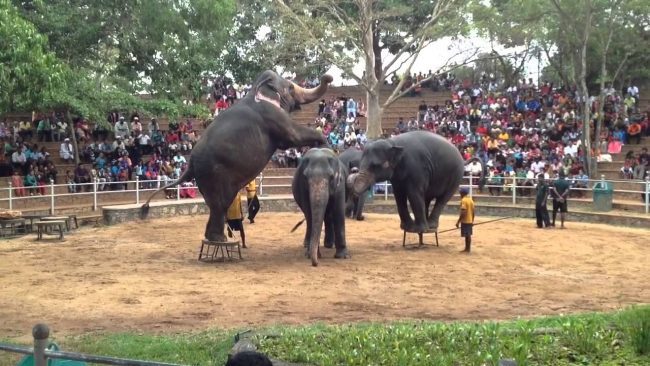
The elephant show at the Dehiwala Zoo/ Image credits: youtube.com
Zoochosis
That sounds a bit like something out of a cartoon, but it is not. Scientists and researchers are now uncovering the disturbing truth about animals kept in zoos ‒ zoochosis. A term coined by Bill Travers, co-founder of the Born Free Foundation, zoochosis is a behavioural problem faced by animals confined in small, empty cages or enclosures. Studies and research have proved that animals can feel bored, depressed, frustrated, or stressed out when they have little room to move around in, and no physical and mental enrichment. Our Dehiwala Zoo fits the bill on both counts ‒ not only do many of the animals (like the big cats) have very little space, but the enclosures are also depressingly bleak and devoid of any stimulation whatsoever, bearing not even the slightest semblance to the habitats these creatures are used to.
So are zoos around the world closing? Not likely. Animal rights activists can howl in protest till they are blue in the face, but zoos will go on. The same can be said of the Dehiwala Zoo. However, it would make a big difference to the creatures in it if the authorities got their priorities right and started improving the conditions in which the unfortunate animals are forced to live in.
Pet Shops From Hell
Yes, the silver arowana is pretty, the puppies can melt your heart, and that crested cockatoo will look just lovely in your hall alcove. But stop and take a closer look ‒ the arowana swims round and round in a tank a mere six inches longer than its length, the puppies are packed together like sardines in a can, and that handsome cage holding the cockatoo actually has barely enough room for the bird to stretch its wings. Most of these small pet shops look attractive enough from a distance, with all the cute rabbits and puppies on display, but closer observation usually reveals the appalling conditions under which these creatures are kept. More often than not, the cages are unclean, unventilated, and cramped, and exposed to all the dust, dirt and noise from the busy roads.
So Is Anything Being Done To Right This Wrong?
As it turns out, policy makers haven’t been completely ignorant or inactive where these issues are concerned. The Animal Welfare Bill was approved by the Cabinet on the January 13 this year. According to the Otara Foundation, this is Sri Lanka’s first monumental step towards the protection of its animals. Of course, this is only one step out of many, but it is a step nevertheless; hopefully, with a little more pressure (or probably a lot more, seeing the way things are run in this country), the others will follow soon. This Bill will replace the ancient Prevention of Cruelty to Animals Ordinance drafted more than a century ago in 1907, which though occasionally amended, is no longer adequate when dealing with prevailing issues. (The maximum fine for cruelty under this legislation is only Rs. 100 ‒ so yes, it’s high time we did away with this archaic law).
Another initiative which seems to be encouraging in terms of animal welfare is the Ridiyagama Safari Park which was opened to the public in March this year. It is early days still, but the project, which aims to educate the public, carry out breeding programmes and provide suitable environmental conditions to its animal inhabitants, seems promising so far.
Many animal rights groups like the Otara Foundation and AWPA (Animal Welfare Protection Association) are actively urging for change with campaigns, events, and awareness programmes.

The Otara Foundation Independence Day Campaign aimed to increase awareness of the plight of animals suffering in captivity/ Image credits: Otara Foundation
There is no doubt that all this plays a significant role in educating people, but Sri Lanka needs to do much more before we can truly say that our animals are protected. As a nation, we have learned the hard way that freedom is a privilege to be cherished. Let us not deprive our animals of this right.
Cover image credit: yamu.lk

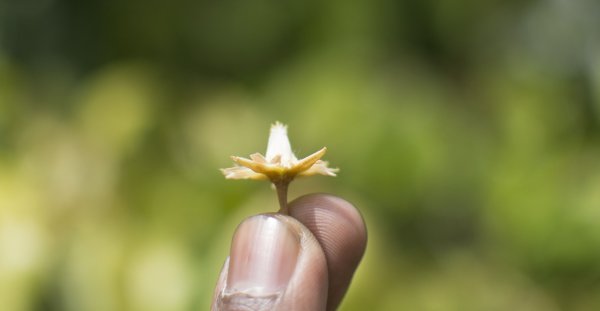
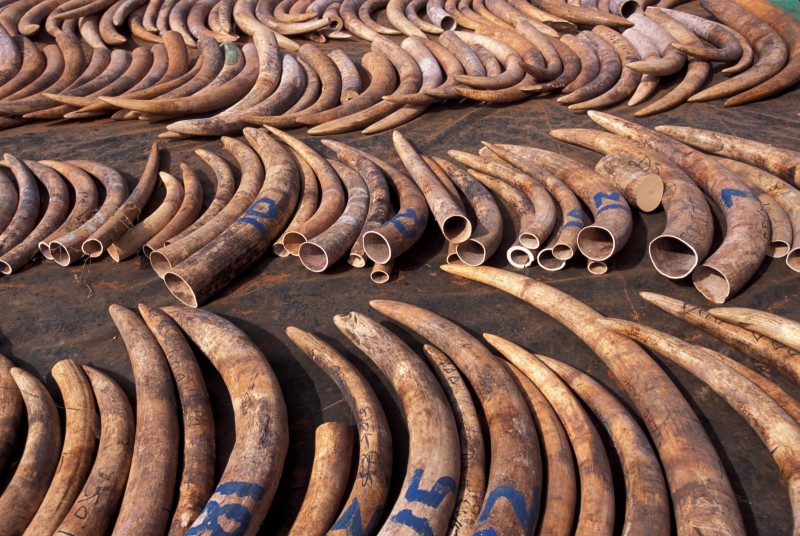



.png?w=600)
